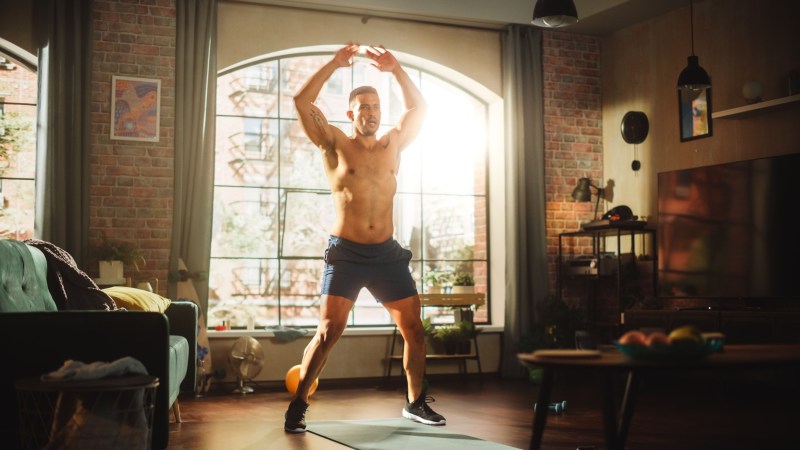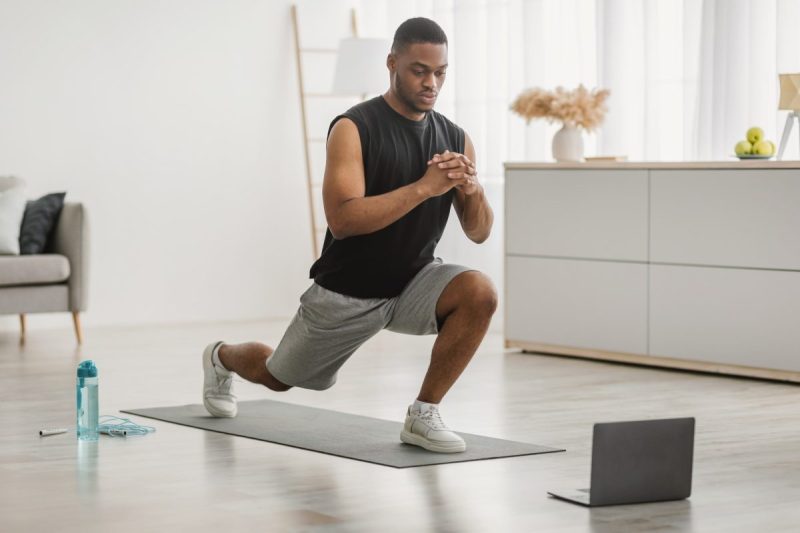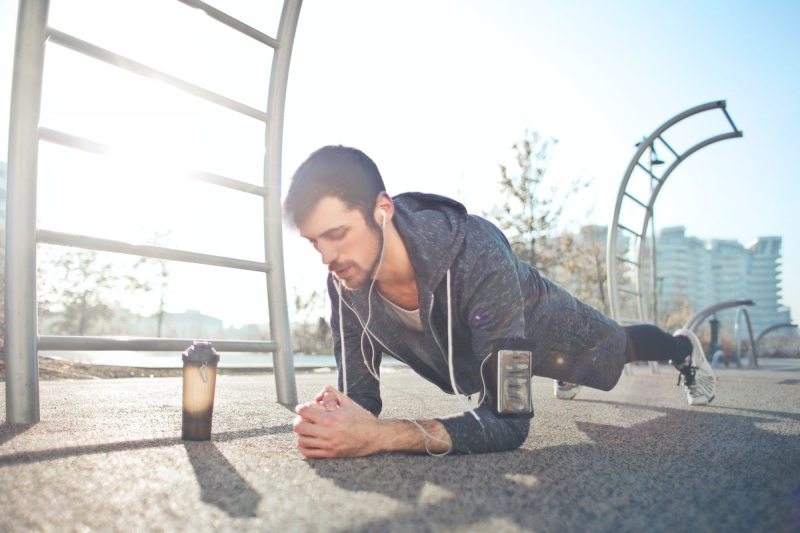While there are an endless amount of workout options out there for you, we’ve compiled the best at-home workouts and exercises to help you get buff, no matter whether you’re a beginner, intermediate level, or advanced. All you need is a healthy mix of strength training and cardio to help you lean out while building muscle. You can work out from the comfort, convenience, and privacy of your own home using just your body weight. You can add weights when you feel ready to up the challenge and start resistance training.
Weight lifting isolates muscles, whereas bodyweight exercises often engage multiple muscle groups at the same time. When you’re ready, get your workout gear on, lay out a mat or soft towel, and let’s hop into some of the best weight-free exercises you can try in the comfort of your home or hotel room.
- Difficulty level — moderate
- Duration — 30 minutes
- What you need — free weights (optional), a towel, and a mat
Warm up

Jumping into heavy lifting with cold muscles is a recipe for injury. Get your body ready to lift and increase muscle circulation by warming up for five to ten minutes. Choose two or three of these stretches or warm-up moves to include in your warm up.
Complete 2 or 3 sets of each move.
Jumping jacks

We all remember jumping jacks, right? Begin with your feet close together and hands and arms loose at your sides. Separate your feet by hopping laterally while bringing your hands together at the top of your head, then hop again to your original position.
Repeat 5 to 10 times.
Knee hugs

Knee hugs help to limber legs, knees, and hip flexors. From a standing position, bring one leg up, hug it to your chest, and step it forward. Step forward and repeat with your other leg.
Repeat 5 to 10 times with each leg.
Lunges

You can warm up your legs and hip flexors with lunges. Take a large step forward to begin. Keeping your front lower leg straight, bend into your rear leg and lower your knee to just above the floor. Step forward and either straighten up to standing or bring the other leg all the way through to bend on the opposite side.
Repeat 5 to 10 times with each side.
Arm circles

Now that your legs and hips are warming, it’s time to get the top of your body involved. Arm circles are exactly like they sound: Twirl each arm forward, one after the other, in a wide circle to get blood flowing into your shoulders and rotator cuffs.
Repeat 5 to 10 times on each side and reverse the action 5 to 10 times as well.
Torso twists

As the name implies, with torso twists, you’ll be twisting your torso, which helps improve your spinal rotation. Start by bringing your elbows up toward your shoulders and (carefully) twist your torso to the right and around to the left. This will help get your chest, back, and spine ready to work.
Repeat 5 to 10 times on each side.
Inch worms

Inch worms are an excellent warm-up for engaging your back, shoulders, and hips. Start by putting yourself in a plank position with your hands on the floor about shoulder-width apart and your feet slightly closer together. Slowly bring your rear in the air as you walk your feet toward your hands, keeping your elbows and knees as straight as possible. After your feet are close to your hands, walk back down to a plank again.
Repeat 5 to 10 times.
Get sweaty

Now that you’re warm, it’s time to get down to it. Again, these exercises tend to incorporate several muscle groups simultaneously as you’ll use your body weight to balance and exert your muscles.
Pushups

The classic pushup is always a central part of any weightless workout because they engage almost all of your upper body muscles if done correctly.
Here’s how to do a pushup:
- Step 1: Starting in a high-plank position, place your hands shoulder-width apart. Splay your middle fingers, pointing toward 12 o’clock.
- Step 2: Bend your elbows and lower toward the floor, keeping your elbows at about a 45-degree angle to your body and your rear parallel to the ground.
- Step 3: When your chest or chin brushes the floor, press your body upward and away from the floor, keeping your core tight and not sagging with your lower back.
- Step 4: When your elbows are fully extended, and your body is back in a high plank position, that’s one rep.
- Step 5: Complete ten to 15 reps of three sets with 30 to 60 seconds of rest in between.
- Step 6: For an extra challenge, there are plenty of pushup variations to hit different parts of your upper body, including Spidermans, diamond push-ups, incline and declines, wide-grip, and close-grip.
Dips

Dips will burn your triceps and shoulders, forcing your arms to lower and lift much of your torso and lower leg weight.
Here’s how to do a dip:
- Step 1: Face away from a chair or a bench, and place the heels of both hands shoulder-width apart. Extend your legs out in front of you with your knees locked.
- Step 2: Slowly lower your body by flexing at your elbows until your forearms and upper arms create a 90-degree angle at your elbows.
- Step 3: Using your triceps, push yourself back to the starting position when your arms are straight.
- Step 4: Complete ten to 15 reps of three sets with 30 to 60 seconds of rest in between.
- Step 5: Doing dips more slowly and deliberately will challenge your muscles more. You can also add reps. If you can balance it, place a weight on your abdomen/pelvic area to push your triceps more.
Forearm planks

Planks are a perfect exercise to shred your abs and obliques. All it takes is holding your body up parallel to the floor.
Here’s how to do a forearm plank:
- Step 1: Place your forearms on the floor with your elbows aligned below your shoulders and your arms parallel to your torso. Your forearms should be about shoulder-width apart. If flat palms bother your wrists, you can clasp your hands together.
- Step 2: Hold your body up for anywhere from 30 to 120 seconds.
- Step 3: Complete three sets with 30 to 60 seconds of rest in between.
- Step 4: For an extra challenge, you can try a number of plank variations to get your heart pumping and your core burning. Hold your body with your hands instead of your forearms, hop and splay your legs, or lift each arm to the sky for several reps.
Squats

Like push-ups, squats are an excellent move to engage your entire lower body while burning upper micro-muscles as you maintain stability.
Here’s how to do a squat:
- Step 1: Begin with your feet shoulder-width apart, knees bent, hips loose, and arms bent at the elbow (or straight out in front of you).
- Step 2: Bend your knees, keep your rear back, and sit into your hips.
- Step 3: Go down as far as you can (try to get at least even with the knees), then push yourself back into the starting position.
- Step 4: Keep your head up and facing forward with your elbows at your side and your back straight throughout this move.
- Step 5: Complete 10 to 15 reps of three sets with 30 to 60 seconds of rest in between.
- Step 6: As your lower body gets stronger, you’ll want to challenge it more. Try holding your arms straight out in front of you like a mummy, and hold weights at your side or a heavy object in front of you as you squat and stand. There are a number of different squat variations you can try.
Split squats

Split squats will burn your core as you keep your torso straight. You’ll also engage your quads, hamstrings, and glutes.
Here’s how to do a split squat:
- Step 1: Stand facing away from a bench or chair with one foot resting on it, toes down. Place your other foot about one large step in front of you.
- Step 2: Squat down into your front leg until the knee of your trailing leg almost touches the floor. Make sure that your front leg can stay relatively straight. Adjust if needed.
- Step 3: Push up through your front foot, returning to the start position.
- Step 4: Complete 10 to 15 reps with each leg. Do three sets with 30 to 60 seconds of rest in between.
- Step 5: To heighten the challenge, hold a set of weights, books, bags, or anything with extra weight at your sides as you move up and down. You can also elevate your back foot to practice more balance and get more burn with a Bulgarian split squat.
Step-ups

Step-ups will burn your lower half and engage your core as you balance for stability.
Here’s how to do step-ups:
- Step 1: Stand with your feet together before a stable knee-high chair or bench.
- Step 2: Step up onto the chair with your right foot, pushing through your heel and driving your left knee toward your chest.
- Step 3: Carefully lower your left leg down, stepping backward in a smooth motion. Repeat with a step-up with your left leg.
- Step 4: Complete 10 to 15 reps with each leg, either alternating by rep or by set. Do three sets with 30 to 60 seconds of rest in between.
- Step 5: Up the ante by grabbing a set of weights, books, bags, or anything with a bit of heft to hold at your sides as you complete the exercise.
Cool down

Cooling down is an integral part of your workout as well. Your muscles are now tight and swollen and more prone to spasms. Repeat some of the warm-up exercises or do some dance or yoga stretches to get flexed striated tissue to ease back to normal and smooth your recovery.
Sample beginner at-home workout

Shoot for 2 sets of 10 to 15 reps at the beginner level until you become more familiar with the exercise. Rest for 30 seconds to 1 minute between each movement.
Here are some of the best at-home beginner-friendly exercises to try:
- Bridge
- Chair squat
- Knee pushup
- Lunge
- Straight-leg donkey kick
- Forearm plank
- Bird dog
- Bicycle crunch
Sample intermediate at-home workout

Once you’re ready to move on from the beginner routine, you can aim for 2 sets of 10 to 15 reps of these at-home intermediate moves:
- Pushup
- Single-leg bridge
- Squat
- Alternating lunge
- Superman
- Side plank
- Dead bug exercise
- Walking lunge
Don’t forget to rest for about a minute before moving on to the next exercise. Alternatively, you can try completing a minute of each exercise and repeating that circuit twice.
Sample advanced at-home workout

When you’ve mastered the intermediate at-home workout, you’re really kicking things up a notch. Try performing 2 sets of 10 to 15 reps for each of these advanced moves, and make sure to rest for 30 seconds to 1 minute after every exercise:
- Jumping lunge
- Overhead squat
- One-legged pushup
- Elevated pike pushup
- Kneeling squat with high jump
- One-leg forearm plank hold
- The pistol squat
- Hollow hold to jackknife
You can also try performing 1 set of each exercise, resting for 1 or 2 minutes, and repeat.
FAQs

Are 20-minute home workouts effective?
Any exercise is better than no exercise at all. That being said, 20 minutes once a week might not be enough to achieve certain goals or to achieve optimal health benefits. The Physical Activity Guidelines for Americans are at least 75 minutes of high-intensity exercise per week or 150 minutes of moderate-intensity exercise every week to enhance your overall health. If your goal is weight loss or muscle gain, you should also consider optimizing your nutrition.
How can I get fit in 30 days at home?
You can definitely improve your fitness in 30 days if you stay committed to your at-home workout routine. You could go jogging for 20 to 30 minutes every other day and try bodyweight exercises like squats, pushups, and lunges. Incorporate exercises that improve your muscle strength and moves that ramp up your heart rate, such as burpees and walking lunges.
What exercises burn body fat?
A blend of weightlifting or strength training and cardio exercises is the best choice for burning belly fat and improving your overall body composition. You can target your abs and obliques with moves like side plank and bicycle crunches. You’ll also need to get your heart pumping with jogging and jumping jacks or burpees. If you’re trying to lose weight and burn body fat, you’ll need to consume a well-balanced, calorie-controlled diet and watch your sugar intake. Weight loss and fat loss are more complex than just diet and exercise alone.
Make a plan

Working out is wonderful for your body, and getting into a routine will satisfy your mind. If you’re just starting out, set a goal for two to three days of weight training, two days of cardio, and two days of rest per week. As you get stronger, you can add a weight day and try splitting between upper- and lower-body workouts. Those rest days are really important for optimal recovery. Working out begins with a first step, whether you’re at home, on the road, or at the gym. Always remember: Improving your day is just a workout away.




